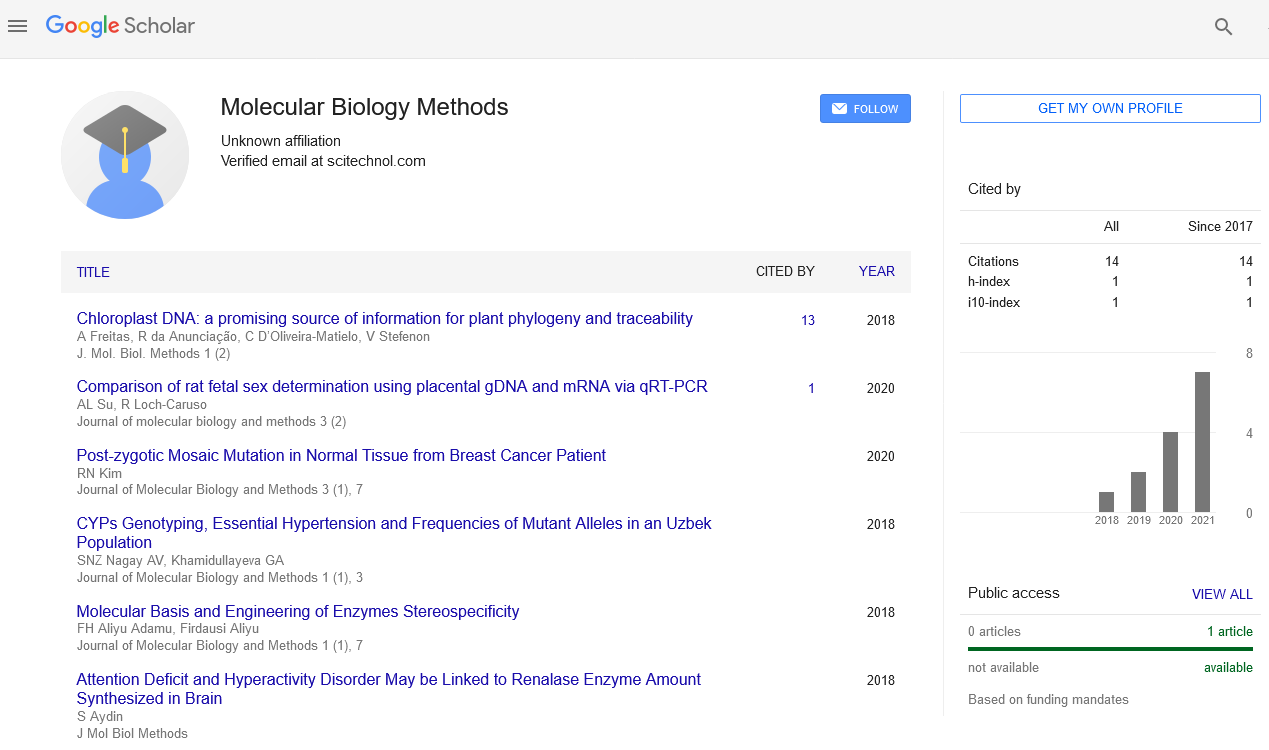Commentary, J Mol Biol Methods Vol: 4 Issue: 5
The Nature and Inheritance of Epigenetic Marks
Paolo Guerra*
Department of Molecular Systems Biology, Groningen Biomolecular Sciences and Biotechnology Institute, University of Groningen, Nijenborgh, Netherlands
*Corresponding author: Paolo Guerra, Molecular Systems Biology, Groningen Biomolecular Sciences and Biotechnology Institute, University of Groningen, Nijenborgh, Netherlands, E-mail: paologuerra@rug.nl
Received date: September 02, 2021; Accepted date: September 19, 2021; Published date: September 26, 2021
Keywords: Epigenetic
Introduction
A vast array of successive epigenetic modifications ensures the creation of a healthy individual. Crucial epigenetic reprogramming events occur during germ cell development and early embryogenesis in mammals. As highlighted by the large offspring syndrome with in vitro conceived ovine and bovine animals, any disturbance during germ cell development or early embryogenesis has the potential to alter epigenetic reprogramming. Therefore the complete array of human Assisted Reproductive Technology (ART), starting from ovarian hormonal stimulation to embryo uterine transfer, could have a profound impact on the epigenetic state of human in vitro produced individuals. Although some investigators have suggested an increased incidence of epigenetic abnormalities in in vitro conceived children, other researchers have refuted these allegations. To date, multiple reasons can be hypothesized why irrefutable epigenetic alterations as a result of ART have not been demonstrated yet.
Defination
Epigenetics is the study of how cells control gene activity without changing the DNA sequence."Epi-"means on or above in Greek,and "epigenetic" describes factors beyond the genetic code. Epigenetic changes are modifications to DNA that regulate whether genes are turned on or off. These modifications are attached to DNA and do not change the sequence of DNA building blocks. Within the complete set of DNA in a cell (genome), all of the modifications that regulate the activity (expression) of the genes are known as the epigenome.
The word “epigenetic” literally means “in addition to changes in genetic sequence.” The term has evolved to include any process that alters gene activity without changing the DNA sequence, and leads to modifications that can be transmitted to daughter cells (although experiments show that some epigenetic changes can be reversed). There likely will continue to be debate over exactly what the term means and what it covers. Many types of epigenetic processes have been identified they include methylation, acetylation, phosphorylation, ubiquitylation, and sumolyation. Other epigenetic mechanisms and considerations are likely to surface as work proceeds. Epigenetic processes are natural and essential to many organism functions, but if they occur improperly, there can be major adverse health and behavioral effects.
Epigenetics is involved in many normal cellular processes. Consider the fact that our cells all have the same DNA, but our bodies contain many different types of cells: neurons, liver cells, pancreatic cells, inflammatory cells, and others. How can this be? In short, cells, tissues, and organs differ because they have certain sets of genes that are "turned on" or expressed, as well as other sets that are "turned off" or inhibited. Epigenetic silencing is one way to turn genes off, and it can contribute to differential expression. Silencing might also explain, in part, why genetic twins are not phenotypically identical. In addition, epigenetics is important for X-chromosome inactivation in female mammals, which is necessary so that females do not have twice the number of X-chromosome gene products as males. Thus, the significance of turning genes off via epigenetic changes is readily apparent.
How Do Epigenetic Changes Affect Genes?
Perhaps the best known epigenetic process, in part because it has been easiest to study with existing technology, is DNA methylation. This is the addition or removal of a methyl group (CH3), predominantly where cytosine bases occur consecutively. DNA methylation was first confirmed to occur in human cancer in 1983, and has since been observed in many other illnesses and health conditions.
Transcription, translation and subsequent protein modification represent the transfer of genetic information from the archival copy of DNA to short-lived messenger RNA, usually with subsequent production of protein. Although all cells in an organism contain essentially the same DNA, cell types and functions differ because of qualitative and quantitative differences in their gene expression, and control of gene expression is therefore at the heart of differentiation and development. The patterns of gene expression that characterize differentiated cells are established during development and are maintained as the cells divided by mitosis. Thus, in addition to inheriting genetic information, cells inherit information that is not encoded in the nucleotide sequence of DNA, and this has been termed epigenetic information. Epigenetics has been defined as ‘the study of mitotically (and potentially meiotically) heritable alterations in gene expression that are not caused by changes in DNA sequence’. However, some definitions of epigenetics are broader than this and do not necessarily encompass the requirement for heritability. For example, the US National Institutes of Health in their recent epigenomics initiative state that ‘epigenetics refers to both heritable changes in gene activity and expression (in the progeny of cells or of individuals) and also stable, long-term, alterations in the transcriptional potential of a cell that are not necessarily heritable’.
 Spanish
Spanish  Chinese
Chinese  Russian
Russian  German
German  French
French  Japanese
Japanese  Portuguese
Portuguese  Hindi
Hindi 